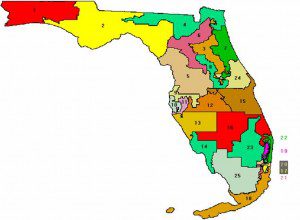A Leon County judge declined to set aside the state’s new congressional maps Monday, saying opponents of the plans had not proven that the Legislature violated new anti-gerrymandering standards in the once-a-decade redistricting process.
It was the latest in a string of significant victories for GOP leaders in the politically-charged battle over the future of the state. The Florida Supreme Court on Friday upheld the Legislature’s second attempt at drawing a map for the state Senate, after justices had tossed an earlier draft, and the U.S. Justice Department told the state Monday that all of its maps had gained preclearance under the Voting Rights Act.
The ruling by Circuit Court Judge Terry Lewis did not fully settle the issues in the case. His ruling only dealt with a request by lawyers for a coalition of voting rights groups and a group of voters backed by the Florida Democratic Party to throw out the maps based on undisputed facts. But Lewis said many of the facts are still in dispute.
And he rejected a request by critics of the maps to issue an injunction that would prevent the state from using the new lines until he could rule on the merits of the case.
“Without a finding that the map as draw is unconstitutional, I do not have the authority to replace it with another map while the case is pending,” Lewis wrote.
He also noted that simply going back to the 2002 redistricting map, which both critics and supporters of the state’s new plan say was politically gerrymandered, would present problems of its own.
The case is the first ruling on congressional map under the Fair Districts constitutional amendments approved by the voters in November 2010. It is separate from the Supreme Court’s consideration of the legislative maps, though the justices could be asked to review Lewis’ ruling and any final decision on the redistricting plan if a trial goes forward.
In one of the most-watched districts of the congressional case — the sprawling Northeast Florida district represented by Democratic Congresswoman Corrine Brown — Lewis did concede that the lines do not gel with many of the standards set out in the Fair Districts standards.
‘It is visually not compact, bizarrely shaped, and does not follow traditional political boundaries as it winds from Jacksonville to Orlando,” Lewis wrote.
But he said opponents had not yet made the case that the district could have been redrawn to better respect those standards while still providing black voters in the area the opportunity to elect a candidate of their choice.
In all, Lewis brushed aside challenges that could have affected more than 20 districts across the state, often saying that he was convinced that the facts about whether those lines violated the law were still in dispute.
In a statement issued late Monday, Democratic Party Executive Director Scott Arceneaux said Democrats were considering their next steps.
“We remain concerned about elements of the map and we will continue to evaluate our legal options moving forward,” Arceneaux said.
By Brandon Larrabee



